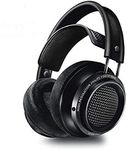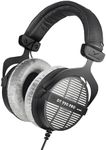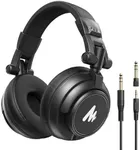Buying Guide for the Best Wireless Open Back Headphones
When choosing wireless open-back headphones, it's important to consider several key specifications to ensure you get the best fit for your needs. Open-back headphones are known for their natural sound quality and spacious audio experience, making them ideal for critical listening and enjoying music in a quiet environment. However, they are not suitable for noisy environments as they do not block external sounds. Here are the key specs to consider and how to navigate them.Sound QualitySound quality is crucial for any headphones, especially open-back ones, as they are designed to provide a more natural and immersive listening experience. This spec is important because it determines how accurately the headphones reproduce audio. Look for headphones with a wide frequency response range (typically 20Hz to 20kHz) to ensure they can handle both deep bass and high treble. If you enjoy detailed and clear sound, prioritize headphones with high-resolution audio capabilities. Your listening preferences should guide you here; if you prefer a balanced sound, look for headphones with a flat frequency response.
Comfort and FitComfort and fit are essential for long listening sessions. This spec is important because uncomfortable headphones can cause fatigue and discomfort. Open-back headphones are generally larger and can be heavier, so look for models with well-padded ear cups and adjustable headbands. The materials used, such as memory foam and breathable fabrics, can also enhance comfort. If you plan to use the headphones for extended periods, prioritize lightweight models with good ergonomics.
Battery LifeBattery life is a critical spec for wireless headphones as it determines how long you can use them without needing to recharge. This is important because frequent recharging can be inconvenient. Battery life can vary widely, from around 10 hours to over 30 hours on a single charge. If you use headphones for long periods or travel frequently, look for models with longer battery life. Consider your usage patterns; if you only use them for short sessions, a shorter battery life may be acceptable.
ConnectivityConnectivity refers to how the headphones connect to your devices. This spec is important because it affects the ease of use and compatibility with your devices. Most wireless headphones use Bluetooth, but the version of Bluetooth can impact the quality and stability of the connection. Look for headphones with Bluetooth 5.0 or higher for better range and reliability. Additionally, some models offer multipoint connectivity, allowing you to connect to multiple devices simultaneously. If you switch between devices often, this feature can be very useful.
Build QualityBuild quality refers to the materials and construction of the headphones. This spec is important because it affects durability and longevity. High-quality materials like metal and high-grade plastics can make the headphones more robust and resistant to wear and tear. If you plan to use the headphones frequently or take them on the go, prioritize models with a sturdy build. Consider your lifestyle; if you are rough on your gear, look for headphones with reinforced components and a solid build.
Sound LeakageSound leakage is the amount of sound that escapes from the headphones and can be heard by others. This spec is important because open-back headphones are more prone to sound leakage due to their design. If you plan to use the headphones in shared or quiet environments, consider how much sound leakage is acceptable. While open-back headphones will always leak some sound, some models are better at minimizing this. If privacy is a concern, you may need to balance sound quality with leakage control.





















